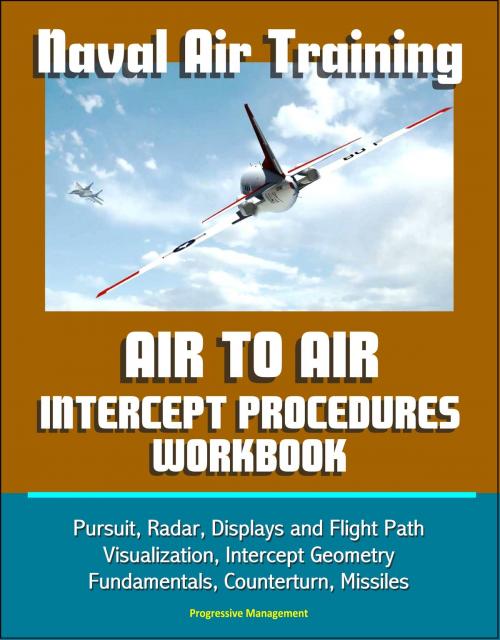Naval Air Training: Air to Air Intercept Procedures Workbook - Pursuit, Radar, Displays and Flight Path Visualization, Intercept Geometry Fundamentals, Counterturn, Missiles
Nonfiction, Science & Nature, Technology, Aeronautics & Astronautics, History, Military, Aviation| Author: | Progressive Management | ISBN: | 9781310066832 |
| Publisher: | Progressive Management | Publication: | June 15, 2014 |
| Imprint: | Smashwords Edition | Language: | English |
| Author: | Progressive Management |
| ISBN: | 9781310066832 |
| Publisher: | Progressive Management |
| Publication: | June 15, 2014 |
| Imprint: | Smashwords Edition |
| Language: | English |
This fascinating guide by the Navy covers training for intercepts by fighter plane pilots. The primary purpose of fighter aircraft is to obtain and sustain air superiority over contested airspace. To successfully accomplish this, the fighter aircrew must execute an intercept in a manner designed to: Attain a position in space between the attacking aircraft and the defended force (positional advantage). Control the intercept geometry to achieve an optimal weapon's Launch Acceptability Region (LAR) and manage the enemy's Weapons Employment Zone (WEZ). This is done to maximize the probability of kill (Pk), while simultaneously preventing the enemy from achieving weapons release. Arrive at the merge with a tally of all bandits and an advantage in position and/or energy. Then the fighter must use basic fighter maneuvers (BFM) to deter or destroy the enemy.
CHAPTER ONE - FIGHTER PURPOSE * 100. INTRODUCTION * 101. METHODS OF INTERCEPTING * 102. TYPES OF INTERCEPTS * 103. PURE PURSUIT * 104. LEAD PURSUIT * 105. LAG PURSUIT * CHAPTER TWO - AIR INTERCEPT CONTROL * 200. INTRODUCTION * 201. BASIC RADAR * 202. E-2 HAWKEYE AND E-3 AWACS * 203. PLANNED POSITION INDICATOR (PPI) SCOPE * 204. RADAR TRAINING FLIGHT PROCEDURES * 205. CONTROLLER/FIGHTER TEAMWORK * 206. CONCLUSION * CHAPTER THREE - DIRECTIVE AND DESCRIPTIVE COMMENTARY * 300. INTRODUCTION * 301. TYPES OF COMMENTARY * 302. VOICE MODULATION * 303. DESCRIPTIVE COMMENTARY (BRAA/AREO REPORTS) * 304. BRAA AND BULLSEYE * 305. AREO * 306. AZIMUTH ANGLE REPORTING * 307. RANGE REPORTING * 308. AREO REPORTS * 309. DIRECTIVE COMMENTARY * 310. TURN COMMANDS * 311. ELEVATION CONTROL COMMANDS * 312. PITCH CONTROL COMMANDS * 313. SPEED CONTROL COMMANDS * 314. COMM BREVITY GLOSSARY * CHAPTER FOUR - INTERCEPT DISPLAYS AND FLIGHT PATH VISUALIZATION * 400. INTRODUCTION * 401. DISPLAYS * 402. EHSI AND AI SCOPE * 403. SPATIAL RELATIONSHIP * 404. GCI INFORMATION * 405. CUT DEFINED * 406. DTG DEFINED * 407. TARGET ASPECT AND ASPECT ANGLE DEFINED * 408. INTERCEPT TRIANGULATION * 409. FLIGHT PATH VISUALIZATION PROCEDURES * CHAPTER FIVE - FUNDAMENTALS OF INTERCEPT GEOMETRY I * 500. INTRODUCTION * 501. INTERCEPT TERMS * 502. FIGHTER POSITIONS * 503. POSITION ADVANTAGE * 504. COMPUTING LATERAL SEPARATION * 505. VERTICAL DISPLACEMENT * 506. ELEVATION ANGLE * 507. RATE OF CLOSURE (ROC) * 508. TARGET ASPECT AND RATE OF CLOSURE * 509. CONCLUSION * CHAPTER SIX - FUNDAMENTALS OF INTERCEPT GEOMETRY II * 600. INTRODUCTION * 601. COLLISION BEARING * 602. DRIFT * 603. BOGEY OFF COLLISION COURSE * 604. PREDICTING ANGLE OFF * 605. CHANGING TARGET ASPECT * 606. PROOF WITH A 180 DTG SET-UP * 607. SPATIAL PICTUR * CHAPTER SEVEN - TARGET ASPECT FORMULA AND COLLISION COURSE CORRECTIONS * 700. INTRODUCTION * 701. TARGET ASPECT VISUALIZATION * 702. RELATIONSHIP OF FIGHTER HEADING TO TARGET ASPECT * 703. CALCULATING THE TARGET ASPECT * 704. TARGET ASPECT FORMULA VISUALIZATION * 705. THE CO-SPEED INTERCEPT * 706. COLLISION COURSE DEFINITION * 707. COLLISION COURSE CORRECTION FORMULA 1 * 708. COLLISION COURSE CORRECTION FORMULA 2 * 709. ILLUSTRATION OF COLLISION COURSE COMPUTATION * 710. ROUNDING * 711. INITIAL DESCRIPTIVE COMM * 712. RECHECKING THE WORK * 713. INTERCEPT GEOMETRY FORMULA REFERENCE * CHAPTER EIGHT - LEAD COLLISION INTERCEPTS * 800. INTRODUCTION * 801. SPARROW ATTACK * 802. FACTORS AFFECTING SUCCESS * 803. LEAD COLLISION * 804. LEAD ANGLE OFF * 805. EFFECT ON TARGET ASPECT IN LEAD COLLISION * 806. ESTABLISHING LEAD ANGLE OFF * 807. CONDITIONS FOR EMPLOYING THE AIM-7 * 808. LEAD ANGLE AND DOT RELATIONSHIP * 809. CONDITIONS FOR LAUNCH * 810. THE SIDEWINDER REATTACK * CHAPTER NINE - DISPLACEMENT TURN FUNDAMENTALS * 900. INTRODUCTION * 901. LATERAL DISPLACEMENT/TURNING ROOM * 902. OBJECTIVES OF THE DISPLACEMENT TURN * 903. ACCOMPLISHING THE DT OBJECTIVES * 904. DISPLACEMENT TURN ILLUSTRATIONS * 905. MINIMUM DISPLACEMENT * 906. REVIEW OF DT PRINCIPLES * CHAPTER TEN - COUNTERTURN FUNDAMENTALS
This fascinating guide by the Navy covers training for intercepts by fighter plane pilots. The primary purpose of fighter aircraft is to obtain and sustain air superiority over contested airspace. To successfully accomplish this, the fighter aircrew must execute an intercept in a manner designed to: Attain a position in space between the attacking aircraft and the defended force (positional advantage). Control the intercept geometry to achieve an optimal weapon's Launch Acceptability Region (LAR) and manage the enemy's Weapons Employment Zone (WEZ). This is done to maximize the probability of kill (Pk), while simultaneously preventing the enemy from achieving weapons release. Arrive at the merge with a tally of all bandits and an advantage in position and/or energy. Then the fighter must use basic fighter maneuvers (BFM) to deter or destroy the enemy.
CHAPTER ONE - FIGHTER PURPOSE * 100. INTRODUCTION * 101. METHODS OF INTERCEPTING * 102. TYPES OF INTERCEPTS * 103. PURE PURSUIT * 104. LEAD PURSUIT * 105. LAG PURSUIT * CHAPTER TWO - AIR INTERCEPT CONTROL * 200. INTRODUCTION * 201. BASIC RADAR * 202. E-2 HAWKEYE AND E-3 AWACS * 203. PLANNED POSITION INDICATOR (PPI) SCOPE * 204. RADAR TRAINING FLIGHT PROCEDURES * 205. CONTROLLER/FIGHTER TEAMWORK * 206. CONCLUSION * CHAPTER THREE - DIRECTIVE AND DESCRIPTIVE COMMENTARY * 300. INTRODUCTION * 301. TYPES OF COMMENTARY * 302. VOICE MODULATION * 303. DESCRIPTIVE COMMENTARY (BRAA/AREO REPORTS) * 304. BRAA AND BULLSEYE * 305. AREO * 306. AZIMUTH ANGLE REPORTING * 307. RANGE REPORTING * 308. AREO REPORTS * 309. DIRECTIVE COMMENTARY * 310. TURN COMMANDS * 311. ELEVATION CONTROL COMMANDS * 312. PITCH CONTROL COMMANDS * 313. SPEED CONTROL COMMANDS * 314. COMM BREVITY GLOSSARY * CHAPTER FOUR - INTERCEPT DISPLAYS AND FLIGHT PATH VISUALIZATION * 400. INTRODUCTION * 401. DISPLAYS * 402. EHSI AND AI SCOPE * 403. SPATIAL RELATIONSHIP * 404. GCI INFORMATION * 405. CUT DEFINED * 406. DTG DEFINED * 407. TARGET ASPECT AND ASPECT ANGLE DEFINED * 408. INTERCEPT TRIANGULATION * 409. FLIGHT PATH VISUALIZATION PROCEDURES * CHAPTER FIVE - FUNDAMENTALS OF INTERCEPT GEOMETRY I * 500. INTRODUCTION * 501. INTERCEPT TERMS * 502. FIGHTER POSITIONS * 503. POSITION ADVANTAGE * 504. COMPUTING LATERAL SEPARATION * 505. VERTICAL DISPLACEMENT * 506. ELEVATION ANGLE * 507. RATE OF CLOSURE (ROC) * 508. TARGET ASPECT AND RATE OF CLOSURE * 509. CONCLUSION * CHAPTER SIX - FUNDAMENTALS OF INTERCEPT GEOMETRY II * 600. INTRODUCTION * 601. COLLISION BEARING * 602. DRIFT * 603. BOGEY OFF COLLISION COURSE * 604. PREDICTING ANGLE OFF * 605. CHANGING TARGET ASPECT * 606. PROOF WITH A 180 DTG SET-UP * 607. SPATIAL PICTUR * CHAPTER SEVEN - TARGET ASPECT FORMULA AND COLLISION COURSE CORRECTIONS * 700. INTRODUCTION * 701. TARGET ASPECT VISUALIZATION * 702. RELATIONSHIP OF FIGHTER HEADING TO TARGET ASPECT * 703. CALCULATING THE TARGET ASPECT * 704. TARGET ASPECT FORMULA VISUALIZATION * 705. THE CO-SPEED INTERCEPT * 706. COLLISION COURSE DEFINITION * 707. COLLISION COURSE CORRECTION FORMULA 1 * 708. COLLISION COURSE CORRECTION FORMULA 2 * 709. ILLUSTRATION OF COLLISION COURSE COMPUTATION * 710. ROUNDING * 711. INITIAL DESCRIPTIVE COMM * 712. RECHECKING THE WORK * 713. INTERCEPT GEOMETRY FORMULA REFERENCE * CHAPTER EIGHT - LEAD COLLISION INTERCEPTS * 800. INTRODUCTION * 801. SPARROW ATTACK * 802. FACTORS AFFECTING SUCCESS * 803. LEAD COLLISION * 804. LEAD ANGLE OFF * 805. EFFECT ON TARGET ASPECT IN LEAD COLLISION * 806. ESTABLISHING LEAD ANGLE OFF * 807. CONDITIONS FOR EMPLOYING THE AIM-7 * 808. LEAD ANGLE AND DOT RELATIONSHIP * 809. CONDITIONS FOR LAUNCH * 810. THE SIDEWINDER REATTACK * CHAPTER NINE - DISPLACEMENT TURN FUNDAMENTALS * 900. INTRODUCTION * 901. LATERAL DISPLACEMENT/TURNING ROOM * 902. OBJECTIVES OF THE DISPLACEMENT TURN * 903. ACCOMPLISHING THE DT OBJECTIVES * 904. DISPLACEMENT TURN ILLUSTRATIONS * 905. MINIMUM DISPLACEMENT * 906. REVIEW OF DT PRINCIPLES * CHAPTER TEN - COUNTERTURN FUNDAMENTALS















